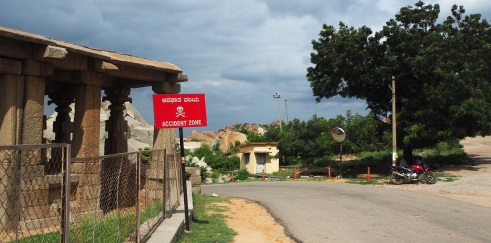Almost eight weeks in India, that sounds like a little and a lot at the same time. Too short a time to get to know this huge country thoroughly, and yet enough time to pour a multifaceted abundance of daily details into one’s brain and soul.

Indiranagar was the neighbourhood I was staying in, and while it clearly ranked among the "better neighbourhoods", it was very different from that what would typically be in a city like Berlin. Nonetheless, the trees, the sounds, the speed, the brightness and brilliance, the colours, the distances, the smells and the languages were also all different. One of the biggest surprises was that Bangalorians speak English with each other. India has more than a hundred different languages, and it cannot be taken for granted that the person next to you on the street comes from the same language region.
I had been invited by media and arts collective maraa to contribute to their project "I Live Here". "I Live Here" explores relationships and new definitions of identity, gender, language and locality in urban space. The members of the collective work situationally; as performers, radio producers and as organizers of concerts and happenings.
I immediately felt very comfortable with Ekta and Angarika, Yashu, Ram and Anushi. However, due to the complexity of their and my own activities (also: botanical excursions), there were occasional minor confusions. Perhaps it is a "typical German" characteristic to tackle an idea right away, perhaps not. Maraa asked me to work with a small group of students (from law to art studies) on sound and identity as part of the "I Live Here" project. However, the straight line is not the shortest route in India, so none of the participants had dealt with recording devices before. Gauri Lankesh's murder had just happened and engaged the public, the media, and of course the minds of my students. We attended one of the extensive demonstrations in College Park, made sound recordings, wrote down our impressions.

"The Megaphone Guerrilla", our poetic street performance series, came about in the light of our new texts and also as a new personal approach to the public. Ekta and I bought megaphones - an exciting shopping spree through the "electric district" of the Krishna market! We had just had time for one and a half rehearsals and then our little group went off to the first metro station (of four) to share songs and sounds with the people.

Amongst all that: an excursion to the botanical paradise of Gurukula in the Ghat Mountains of Kerala, necessitating adventurous train and bus travels and jeep rides. There were interviews about the horticultural scene in Bangalore with Poonam Bir Kasturi from Daily Dump, Richard Gomes from WorkbenchProject in Halasuru and Suresh Jayaram from the gallery Shanti Road, as well as a trip to Tirur to the Ayurveda garden of Kottakal as part of a self-directed experiment by the Ghandian Health Hygiene Home where great emphasis is placed on coconut milk massages, being in touch with nature and the cultivation of the local body of songs.

India means the impossible becoming simple, the seemingly simple becoming strangely complicated. It took more than a week to make an appointment for the visit and secure an interview with the director of the gardens, only to then find out that communication is also possible by using the Latin plant names: Not everybody is fluent in English.
While staying at the cococut cookoo’s home, I started on preparations for "Resounding Bangalore", the final performance planned for late October. Composition, action and radio art -, all in one, and a private home (I live here!) as the location. At the same time I redesigned the print documentation of our Megaphone Guerilla Walk, which was finally effectively tabled on time.

The
bangaloREsidency was a very intense time - even a month and a half after my return to Berlin the impressions keep echoing in my mind. The collaboration with Maraa has greatly enriched my artistic work. The fact that Ekta, Angarika, Yashu, Anushi and Ram possessed a network of friendships and contacts that I as a simple traveler could have never built up so quickly proved invaluable. Whatever I needed, they always had an idea for how to implement it, and a phone number. Above all, they were registered with the Indian bus and train companies, which was a prerequisite to buy tickets online.
Furthermore, I am very grateful to the Goethe-Institut for the excellently organised excursions and the support of the ‘buddies’, in my case Nandita, who was there for all other organisational questions.

India is ‘augmented reality’, an augmented reality that goes far beyond what is imprinted on - even as an artist - one’s senses and dimensional perceptions from Central Europe. I am extremely grateful to maraa and the Goethe-Institute, above all Maureen Gonsalves and Claus Heimes for their invitation. I can also very well imagine further collaboration in the future. My hard drives still host material for several future radio broadcasts and compositions; for now, however, you may view and/or download the documentation
"The Megaphone Guerrilla" on academia.edu. Further contributions and interviews on the horticulture(s) of India will be soon available as a part of my Berlin/international project
Datscha Radio online.
Namasté!






